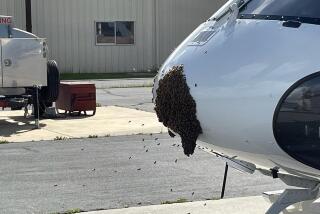Science / Medicine : Waging a War on Killer Bees
- Share via
MEXICO CITY — Agricultural experts in the U.S. and Mexico are joining forces in a bid to halt the northward flight of Africanized bees. The scientific battle targets more than the insects’ nasty sting: There is a threat to honey and crop production, and the economic stakes are high.
Volatile males hungry for sex are lured by the unmistakable perfume of a willing mate and then, once drawn into a trap, face slow, suffocating death. An equally lusty female, attracted by the seemingly desperate call of an abandoned all-male harem, bursts instead upon an empty chamber that will soon become her crypt.
The erotic plot of a paperback thriller? Hollywood’s latest encounter with casual and violent sex? No, merely part of a plan to halt the advance of the Africanized “killer” bee into North America.
Agricultural experts from Mexico and the United States are joining forces in a three-year, $9-million program to halt or at least delay the bee’s flight northward. The effort--set to get under way in a matter of weeks--will apply the latest in bee research to stop the often dangerous insect. The scientific warfare includes lures that exploit the killer bee’s busy mating habits.
The economic stakes in the binational battle are high, for the Africanized bee threatens both honey and crop production. Mexico has grown to be the world’s fourth largest honey producer after China, the United States and the Soviet Union. Honey exports earn the country $50 million a year.
The United States produces $200 million worth of honey annually; moreover, the cultivation of several American crops depends on professionally organized bee pollination. In California alone, yearly almond crops valued at about $320 million are mainly pollinated by honeybees.
32-Year-Old Problem
The problem of the Africanized bee began 32 years ago, when a breed called the African bee was introduced in the Western Hemisphere by way of Brazil. The African bees roam Africa from Senegal to South Africa but were brought to South America by experimenting Brazilian scientists who let them escape. They have been migrating northward ever since.
Until the arrival of the African bee, the Western Hemisphere was dominated by bees of so-called European or Italian stock. European bees are more docile and produce more honey than the African bee. But genetically, the traits of the African bee are dominant; a European strain of bee becomes Africanized when it crossbreeds with bees carrying genes from the African bee.
The best-known trait of the Africanized bee is its nasty stinging--hence the popular nickname killer. While the bee’s venom is no more potent than the European bee’s, the Africanized insects sting in larger swarms and generally pursue an intruder for a longer time over a greater distance.
Such temperamental behavior creates problems for both beekeepers and the general public. Beekeepers must protect themselves more thoroughly with clothing and nets and handle the bees more gingerly. Touchy Africanized bees flee at the slightest provocation and may suddenly take up nesting somewhere else far away.
An innocent passer-by who happens upon a hive might have to run 200 yards to escape enraged bees. Recently a beekeeper in Costa Rica was stung to death, the first known instance of a professional bee breeder being killed by Africanized bees. Deaths by bee stings elsewhere are difficult to confirm.
“They’re unpredictable,” said Janna Evans, a spokeswoman for the U.S. Department of Agriculture in Mexico City. “Sometimes, for instance, they just take to the color black and swarm all over and sting like crazy.”
Professional pollinators who transport bees to farm and field face the problem of controlling the bees. Fields might have to be abandoned by human workers while the bees pollinate the crops.
“Who is going to be legally responsible for stinging bees? They’re aggressive as hell,” said Thomas Rinderer, a researcher for the U.S. Agriculture Department in Louisiana. “I’ve been working with bees for 15 years. I can tolerate a lot out of bees. But I wouldn’t want to be around these bees.”
Not only is the Africanized bee grumpy, researchers say, but it devours much of its own honey, thus making it a less efficient honey producer than the European bee.
The agriculture departments of Mexico and the United States are making what may be the last stand against the killer bee. The program is centered on the Isthmus of Tehuantepec, a narrow strip of southern Mexico between the Pacific Ocean and the Gulf of Mexico.
Isthmus War Zone
A 100-mile long sector of the isthmus has been designated by the warlike acronym BRZ, for Bee Regulated Zone, where the sexual combat will take place. It is considered important to attack mating habits, because the Africanized bees are more prolific breeders than the Europeans. European queens live for six months and lay 1,500 eggs a day while Africanized queens live more than eight months and lay about 2,000 eggs daily.
Spraying insecticides to wipe out killer bees is no solution; such a measure would also eliminate the benign European species as well.
Rather than coexist with other bees, Africanized bees take over hives, push aside rivals and dominate mating.
Africanized drones are often on the lookout for lonesome queens in European hives. When they find one, they invade the hive and make themselves at home. To waylay cruising killer bees, scientists have replicated chemicals called pheromones, a kind of perfume that is naturally secreted by a queen to attract mates.
Traps baited with the queen pheromone will be set throughout the isthmus to catch swarming Africanized drones. Once the bees are inside the vacant traps, beekeepers can tie them up in plastic coverings, and the imprisoned drones will die of heat and lack of oxygen.
At the same time, swarms of European drones will be let loose in the area to better the odds that the resulting new generation of bees will be heavy with European offspring.
The Africanized queen bee is an aggressive mate, as well, and the target of sexual lures. Not content to sit home and wait around for fawning drones to fly in, she often goes out and looks for hives already inhabited by European queens. The Africanized queen enters with a gang of asexual worker bees, kills her rival and takes over mating.
Scientists hope that this nervy behavior, too, will prove to be the killer bee’s downfall. They plan to set traps with a “sad” pheromone that bees secrete when their hive is missing a queen. This plaintive chemical message should attract the Africanized queen to a trap from which she can be collected and killed.
Special barriers are also going to be placed on doors to European hives to keep Africanized queens out. The Africanized queen bees are somewhat plumper than their European counterparts and cannot fit through the barriers. Farmers are being told to check commercial hives every so often to make sure a killer queen has not intruded.
Zones to the east and west of the BRZ are being set up to plug possible gaps in the migration obstacles. East of the BRZ to the Guatemalan border, agricultural inspectors have been ordered to look closely for bees on fruit shipments and other cargo moving on Mexico’s roads. Killer bees have been found as far north as Tamaulipas, a frontier state in Mexico, and in California, where six colonies of the bees were found, and then destroyed, in Kern County. Those bees were believed to have arrived on oil well equipment shipped from South America.
To the west, traps will be set to pick up swarms that somehow overfly the BRZ.
The killer bees invaded Mexico last fall from Central America. The Mexican government moved immediately to try to trap drones. To warn of possible bee attack from newly Africanized hives, the government put up signs up that said, “Caution--Do Not Disturb--Bees at Work.”
Despite the early effort, Eduardo Pesqueira, the secretary of agriculture, has warned that because of the invasion, Mexico’s honey production may decline by half.
Brazilian scientists, whose colleagues originally brought the bees to South America in 1956, claim that the bees have received undue bad publicity. The buzz of the Africanized bee is worse than its bite, they assert, and the bees have helped Brazil move into big-time honey production.
“There are no more deaths from bee stings than from dog or snake bites,” said Leonel Goncalves, a researcher at Sao Paulo University in Brazil.
However, despite living in the warm climate of South America’s largest country, the bees of Brazil produce only 30,000 tons a year of honey compared to Mexico’s 68,000 tons.
The Africanized bees reached Bolivia in 1968, Venezuela in 1977, and the isthmus of Panama in 1981, all along the way leaving behind tales of attacks and reduced honey production. The bees neither crossed the snow-capped southern Andes into Chile nor into frigid Patagonia in the south of Argentina. That pattern has led some scientists to believe that the bee will not be able to withstand the climate in high regions of Mexico and the frigid northern United States.
In any event, it is clear that they will be able to thrive in the temperate climes prevailing along the western and southern coasts of the United States.
Bee experts on both sides of the border hope that while the Africanized bee is delayed at the BRZ, scientists will come up with some way of either destroying it, changing its behavior, or counterattacking with some new breed of bee.
This last tactic would involve development of a bee strain to do to the killer bee what it does to the European: take over its hives and mate with its queens. It is hoped that a new super bee, while being an aggressive mate, would not endanger outside intruders and so relieve the danger to beekeepers and bumbling bystanders alike.
THE AFRICANIZED BEES
The Africanized bee problem began 32 years ago, when this breed was introduced in the Western Hemisphere. The bees, which roamed Africa from Senegal to South Africa, were brought to South America by scientists in Brazil. The bees promptly escaped, and they have been migrating northward since.
Bees in the Western Hemisphere were mostly of European or Italian stock. They were more docile and produce more honey than the African bee.
Both types look virtually identical; but genetically the traits of the African bee are dominant, so a European strain of bee becomes Africanized when it crossbreeds with bees carrying genes from the African bee.
The best-known trait of the Africanized bee is its nasty sting. While the bee’s venom is no more potent than the European bee’s, the Africanized insects sting in larger swarms and generally pursue an intruder for a longer time over a greater distance.
Reach Bolivia in 1968, Venezuela in 1977, Isthmus of Panama in 1981 and Mexico in 1986.
At Isthmus of Tehuantepec, Mexican and U.S. scientists are making what may be the last stand against the Africanized bee.
WORLD PRODUCTION OF HONEY: 1984 In thousands of Metric Tons
1 U.S.S.R. 198.0 2 CHINA (mainland) 115.0 3 UNITED STATES 95.0 4 MEXICO 55.0 5 CANADA 44.1 6 ARGENTINA 33.0 7 BRAZIL 27.0 8 AUSTRALIA 24.5 9 WEST GERMANY 18.0 10 JAPAN 7.6 WORLD TOTAL 940.0
SOURCE: Commodity Yearbook, 1985






